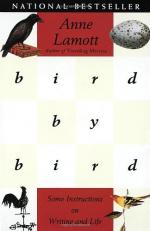
|
| Name: _________________________ | Period: ___________________ |
This test consists of 15 multiple choice questions and 5 short answer questions.
Multiple Choice Questions
1. How does Anne tell her students to train the unconscious to kick in?
(a) Phone an off-putting friend, that will get your creative juices going.
(b) Drink wine and eat chocolate, then write.
(c) Sit down to write at approximately the same time every day.
(d) Listen to classical music.
2. Ten days before Pammy died, she went shopping with Anne. On this excursion Anne figured out what Pammy's essence was. What was it?
(a) It was about who she was, not her clothes.
(b) It was about her checks and her clothes.
(c) It was about who she was, not what she could do with her hands.
(d) It was about how well she wrote checks.
3. What is a plot treatment?
(a) A road map of the beginning and end of a chapter, and how the end grows into the following chapter.
(b) A treatment of the dialog in the book.
(c) It treats the false starts in a book.
(d) It is something done by a big plotting machine.
4. What was Vonnegut's comment on writing?
(a) Writing is an extension of the soul onto a blank canvas in sheer poetic movements.
(b) When I write, I feel like an armless legless man with a crayon in his mouth.
(c) I write with crayons, it is prettier.
(d) When I write, I shoot for the stars and end up somewhere on the moon.
5. When will you know your characters, according to Anne?
(a) When your editor tells you who they are.
(b) When you first sit down and start to write about them.
(c) After teatime.
(d) Weeks or months after you started working with them.
6. In Anne's opinion, who writes bad first drafts?
(a) All good writers.
(b) The birds.
(c) Reporters.
(d) She does.
7. What does Anne tell her students the reason to write is?
(a) To create books.
(b) To get noticed and make lots of money.
(c) To get published.
(d) To find a good agent.
8. The school lunches writing assignment combines which two pieces of writing advice from Anne?
(a) Read poetry and drink wine.
(b) Eat chocolate and take plenty of naps.
(c) Get started and consult a hypnotist.
(d) Short assignments and bad first drafts.
9. When a student is having difficulty writing, what does Anne ask them about?
(a) The current time and temperature.
(b) How messy they were as a child.
(c) About the wire thingy on champagne bottles.
(d) Their school lunches.
10. When a character takes on a characteristic that you have no good experience in, what should you do?
(a) Look at your plot, it will tell you what to write.
(b) Contact someone who has this life experience.
(c) Google the characteristic, everything online is true.
(d) Wing it, the readers will not know.
11. What can yield strange characters lurking in the shadows, according to Anne?
(a) Meditating.
(b) Taking a short assignment and writing a bad first draft.
(c) Eating school lunches.
(d) Working on a good plot line.
12. Paying attention is a powerful antidote for what?
(a) A hangover.
(b) Paranoia.
(c) The rational mind.
(d) Sleepless nights.
13. How does Anne describe writing for herself and most other writers she knows?
(a) Rapturous.
(b) Dewy and thrilled.
(c) Elegant.
(d) Not rapturous.
14. What is a recurring problem that Anne sees in her students?
(a) They really want to be published, and kind of want to write.
(b) They do not have good agents.
(c) They are too busy writing to listen to her class.
(d) They are bad spellers.
15. How else does Anne say you might you know you are done?
(a) You have done the best you can do, and have no more to give.
(b) The plot has come together beautifully.
(c) Your check arrives in the mail.
(d) Your editor tells you that you are done.
Short Answer Questions
1. Instead of writing towards a plot, what does Anne suggest?
2. Where did Anne's father teach his class?
3. How does Anne describe the Polaroid?
4. What is Anne's response when her students ask her for the best writing advice?
5. What do we want out of important characters, such as a narrator?
|
This section contains 773 words (approx. 3 pages at 300 words per page) |

|




